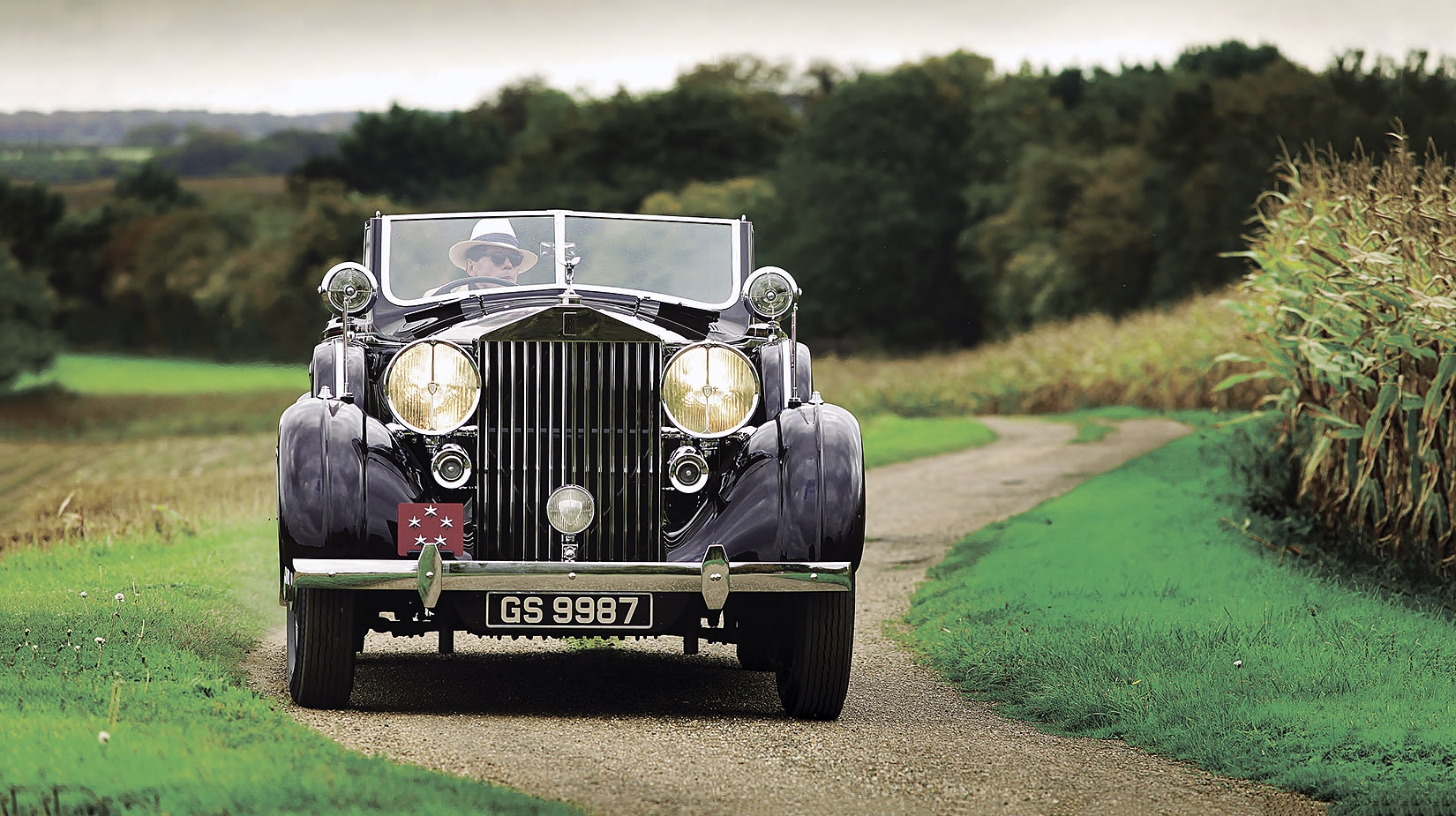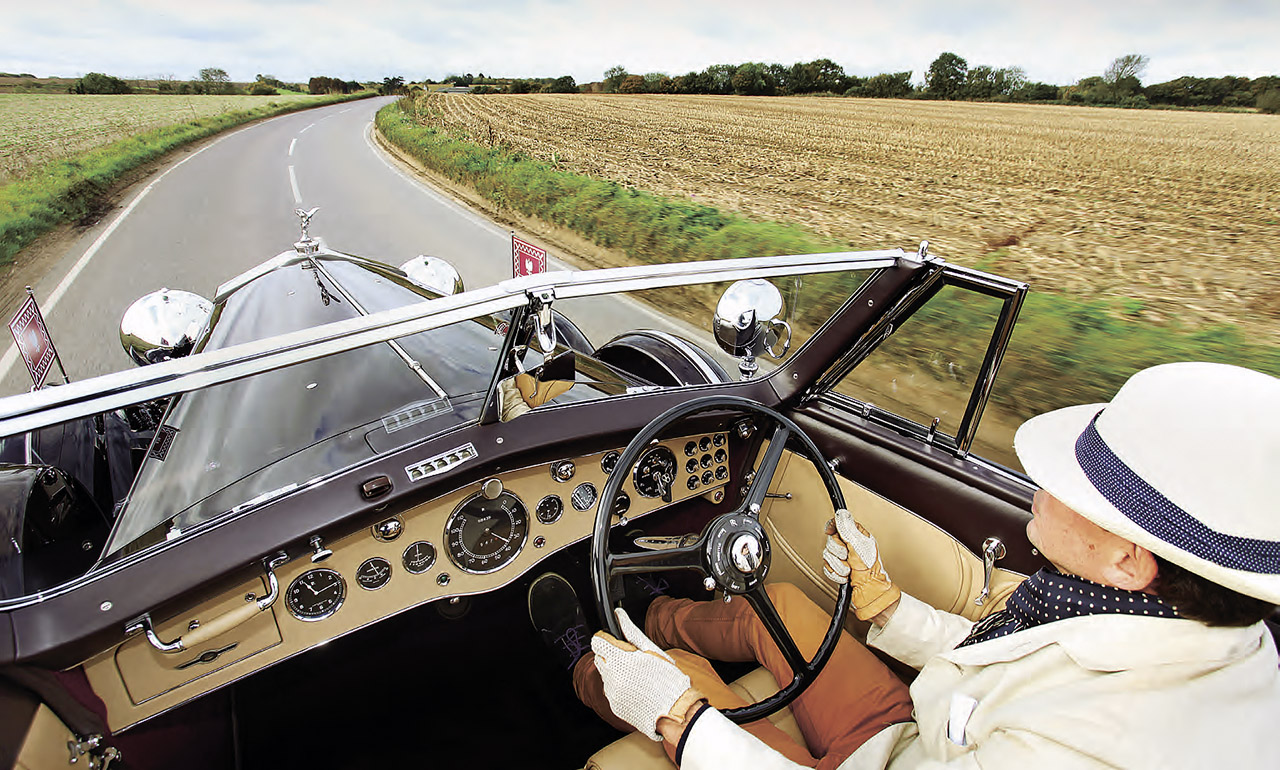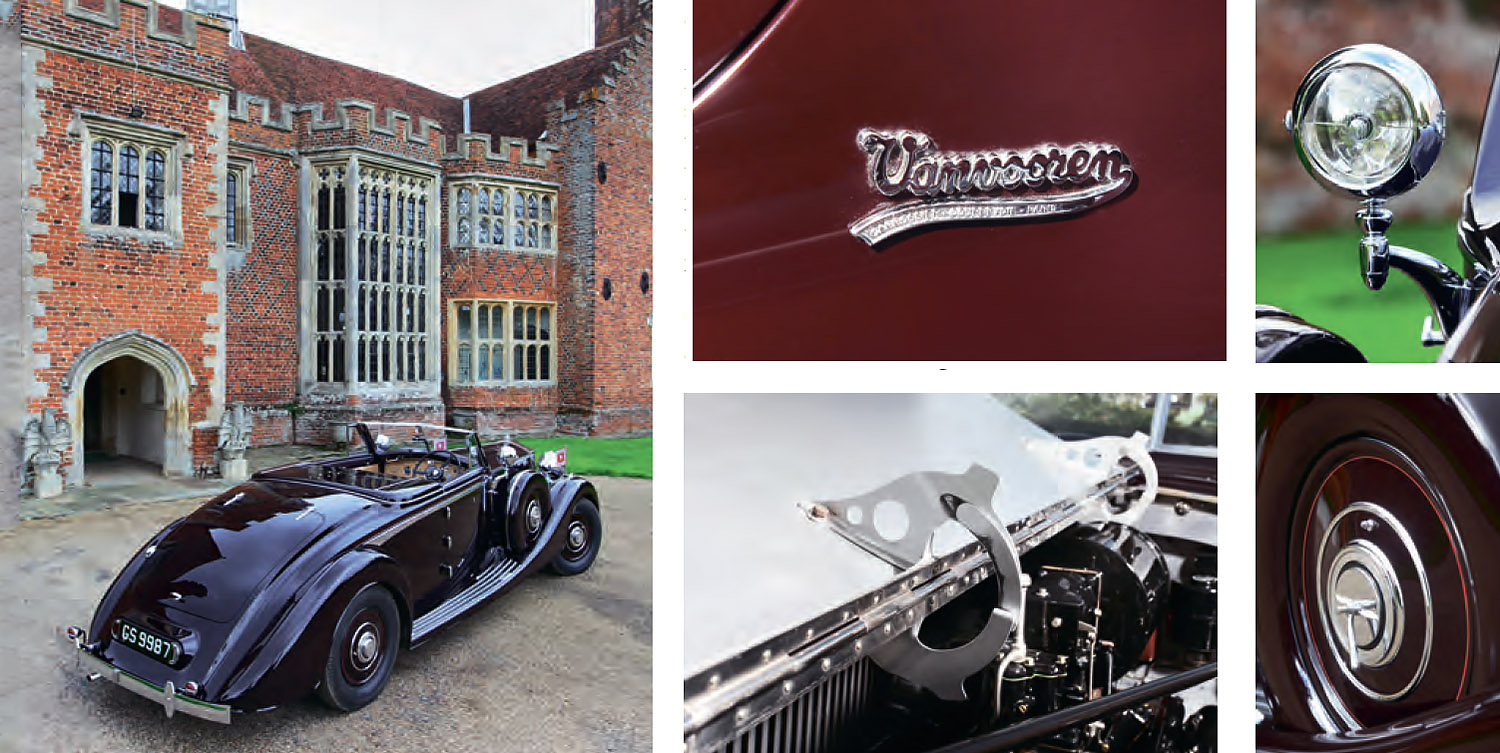
Super-rare Rolls-Royce Phantom III Drive-MY exclusive test of a sensational Vanvooren beauty. The most sophisticated Rolls-Royce ever built. Henry Royce’s technical legacy was the V12 Phantom III. Mick Walsh drives the fabulous Vanvooren cabriolet. Photography James Mann.
Many believe that the Phantom III was the last proper Rolls-Royce, the ultimate pre-war model with direct connections to Frederick Henry Royce before his ashes were placed in the Number One shop at the Derby works in April 1933. Other trusted men may have completed the engineering of the flagship, but it was the founder’s plan that motivated the talented team when work started on the new model in 1932.
The first thoroughly modern Rolls-Royce was clearly influenced by American design practice, specifically its V12 engine configuration and front suspension, which was based on a General Motors design. Yet the Phantom III was an uncompromising tour de force that lost money on each unit built but faithfully fulfilled the company’s promise to its wealthy clientele.

A drive in the unique Vanvooren-bodied roadster featured here soon confirms the Phantom III’s remarkable refinement, particularly the smooth power from its all-aluminium 7.3-litre 24-plug V12. There’s no key, just the main ignition switch and a button. After a brief whirr, the engine catches and instantly settles to a barely audible thrum. As restorer Andrew Wood of Essex-based specialist P&A Wood points out: “It’s so quiet at idle that people don’t think it’s started.” Rolls-Royce insisted on a single-pipe exhaust exit, so the muted note wasn’t split. Engineers claim that multiples of three make the smoothest engines, and this double-six proves it.
The V12’s response is deliciously refined, while its seamless torque effortlessly pushes this 3-ton cruiser along. The fully synchromesh gearchange – via a stubby lever located to the right by the driver’s leg – is slow, yet its action is rewardingly light and fluid once the oil is warm.

“Just count to four between changes,” advises Wood, but you barely need to use the ’box with such reserves of torque. The worm-and-sector steering feels heavy when manoeuvring, and the turning circle – with 3.3 turns lock to lock – is huge, although the action through the broad wheel soon lightens once you’re rolling. There’s little self-centering, so my hands are kept busy unwinding the wheel along twisty backroads.
As the first Royce with independent front suspension, the Phantom III chassis immediately feels more advanced than previous solid-axle models, the coil-and-wishbone set-up flowing over road bumps with no tremor or steering kickback. There’s no rev counter and the distant purr of the exhaust gives little clue to the engine’s performance, but the Phantom has impressive legs once into top on a clear straight road. Only the rush of wind and slight tyre rumble intrude as it wafts along, allowing the driver to enjoy every aspect of the car’s glorious over-engineering. Thankfully, the servo-assisted drum brakes inspire confidence when an impatient modern motorist spoils this serene driving experience.
The Phantom III’s deceptive abilities are confirmed by Wood: “They handle really well. It’s a very complex car, which you sense when driving it. There’s surprisingly little roll and you can chuck them around. The dampers front and rear are automatically controlled by a hydraulic pump that’s mounted on the gearbox. It’s governed by road speed, so the faster you go, the firmer the ride gets. This can also be over-ridden by a lever at the bottom of the wheel.
“The steering should be silky if the balljoints are set up correctly, and the brakes are excellent. One of our clients demanded that his car was tested at 100mph, and it pulled up well for its weight. A few modern drivers got a shock when it came flying past on the M11, but the brakes work better the quicker it’s moving because the Hispano-type servo is driven off the gearbox.”

Clockwise, from left; Vanvooren built four bodies for Phantom IIIs; famous Spirit of Ecstasy; switch cluster; elegant overrider and lamp; Polish pennant; “PIII” chassis plate; magnificent all-alloy 7340cc 24-plug V12.
Rolls-Royce had a long tradition of extensively road-testing its new models, and the Phantom III was no exception. Chassis 34EX, fitted with a Park Ward limousine body, was driven for 12,500 miles over 34 days. The route ran through France and across to North Africa, where it headed for Nairobi via the Sahara desert and back to England. Modifications for this regal transport included a larger fuel tank, a beefed-up clutch, louvred bonnet and oversized tyres.
‘I cannot think of a more unsuitable car to use,’ reported Arthur Robotham, head of the experimental department, ‘but it never once became stuck or required a drop of water.’
Robotham also took a Phantom III to America in 1937, where its performance was checked against various American models including a Buick Straight-8. The Autocar was loaned a limousine for testing, recording a 0-62mph real time of 16.8 secs and a top speed of 92mph. Considering the bodywork’s wind resistance and the weight propelled by the 180bhp engine, such a figure is outstanding. The quickest Rolls so far built, the Phantom III was, however, outperformed by the lighter and more sporting Hispano-Suiza J12.
‘WHEN FORCED TO ESCAPE THROUGH ROMANIA TO PARIS, GENERAL SIKORSKI DROVE THE PHANTOM III’
The Phantom III’s groundbreaking spec and peerless quality didn’t preclude problems with early cars that frustrated buyers. Sustained highspeed driving on new highways in Europe and America brought about overheating, but worse were engine maladies caused by the new hydraulic valves and an unusual oil cooler that required thorough cleaning – a chore that chauffeurs were reluctant to perform. In the end, many of the V12 motors were converted to solid tappets. The new model proved to be much costlier to build than anticipated. It was the last model for which the Derby works made virtually every component, although government aero-engine contracts fortunately carried the company.
Chief designer Albert G Elliott worked closely with Royce for many years but, unlike the company founder, he wasn’t a practical man. Elliott’s designs were pretty and neat though he didn’t take into account the car ever having to be taken to pieces for an overhaul, nor was he in the least concerned about the cost of production.
“It was the most sophisticated car Rolls-Royce ever built,” says Wood, who is passionate about the Phantom III’s methodical engineering. “It’s all about threes. Three times more complicated, three times longer to build, and three times as expensive. The choke mechanism, with its bearings, friction devices and universal joints – all for a little lever control – is typical of the car.”
Few British owners have invested in a full body-off rebuild due to the car’s complexity, but that looks to be changing. “It’s something that we’ve always wanted to do,” says Wood’s brother Paul, “and Lord Anthony Bamford with the Vanvooren cabriolet was the first enthusiast to commit to one. We’re very lucky now to have three in the workshops, so finally collectors are starting to appreciate this magnificent car.”

Clockwise, from right: French-style interior features distinctive leather-upholstered dashboard; fully enclosed hood design; beautifully fabricated bonnet hinges; Marchal spotlight; twin side-mounted spares.
This glamorous drophead features the only two-seater body fitted to a Phantom III, and has a fascinating history that included its role as the unlikely transport of an eminent Polish military hero. Factory records show that the chassis was finished in late 1937 and, on 8 November, it went by rail from Derby to London before shipment to Boulogne upon consignment to the French agent Franco-Brittanic Autos. A one-off drophead cabriolet body was ordered by Count Stefan Czarnecki, a Polish arms dealer with homes in Paris and Warsaw. Vanvooren Carrosserie, based in the Courbevoie district of Paris, was instructed to build the body, which was delivered to Czarnecki on 15 April 1938.
It’s believed, however, that the Count was the agent for General Władysław Eugeniusz Sikorski. Born in 1881, Sikorski was a distinguished officer with the Polish Legions during WW1 before moving into politics. The Vanvooren cabriolet was delivered to Warsaw, but the following year, as the German army advanced into Poland, Sikorski’s request to take military command was refused by Marshal Edward Rydz-S´migly. When Sikorski was forced to escape through Romania to Paris, it’s thought that the Phantom III was his transport. By August 1941, he had been elected Prime Minister of the Polish government in exile, and his prized Royce was registered GS9987 for his use in Scotland. In 1943, however, Soviet leader Joseph Stalin broke off diplomatic relations after Sikorski’s request for an investigation into the Katyn Forest massacre. Two months later, a Liberator carrying Sikorski and his daughter plunged into the sea just after take-off from Gibraltar. His death was a major blow to the Polish cause.
In March 1944, the Phantom III turned up at London dealer Jack Barclay when 3CM81’s mileage was recorded at 15,372. After various owners, the car was acquired by Alfred Beaumont who treasured it from 1949 until his death in 1968, when it vanished to the US. The Vanvooren cabriolet is the favourite of many Rolls-Royce connoisseurs, including its current owner Lord Bamford.
“I read about the car in the ’60s,” he explains, “but no one seemed to know where it was. I later discovered that Long Island resident John Harwood had imported it to the States. I’d always loved its unique details, such as the flush hood design and the unique leather dashboard, which was very French. Amazingly, the car eventually turned up about 10 miles from where I worked when its American owner relocated to the UK with his new wife. We’re not sure about the original colour, but we believe that it could have been black with a powder blue interior.”
The Phantom III looked cosmetically fine when it arrived at P&A Wood in 2012, and Lord Bamford’s brief was to keep it original. But what was expected to take 12 months turned into a two-year rebuild to prepare it for Pebble Beach.
“The windscreen was a classic case,” recalls Paul Wood. “The steel inserts had rusted in the brass frame. It would have been much easier just to make another, but Lord Bamford wanted to keep the factory details, which we appreciated.”
Dave Lowe supervised the coachwork restoration, while the complex engine and chassis were rebuilt: “I really rate Vanvooren’s work. It was a quality French coachbuilder. While most English bodies were aluminium, this was steel on an ash frame. They must have made a full jig, and rolled the panels with an English wheel.”
As well as the handsome, sweeping body lines, the Vanvooren design also has many exacting attributes. “All of the mouldings and trim marry up, and flow together,” enthuses Lowe. “The hood mechanism is also beautifully engineered.” Using a centre hand crank behind the seats, the top cover winds forward before the substantial hood frame folds back. To the sides are storage boxes that neatly hold the removable side panels.
“The interior is superbly thought out,” he adds. Having marvelled at the rebuilt chassis in P&A Wood’s premises before the body was refitted, to me the Vanvooren cabriolet looked a certain Pebble Beach winner. After topping its class, the Anglo-French beauty lined up with the final four contenders – all of which were V12-powered greats: Frank Ricciardelli’s 1934 Packard Dietrich Victoria Convertible, Bob Lee’s rakish Hispano-Suiza J12 Fernandez & Darrin Coupe de Ville and, unexpectedly, Jon Shirley’s ex-Roberto Rossellini Ferrari 375MM.
How close the Phantom III came to landing the ultimate concours crown isn’t recorded, but rumour has it that the Royce was a close second to the 375. “The judging time is limited,” says Paul Wood. “We didn’t get a chance to demonstrate the lifts, and had even made wooden blocks to go under the four jacks to stop them from sinking into the lawn.” I’m sure that this feature would have wowed the judges because I’ve since seen it in action. There’s a hinged cover under the front passenger floor that reveals three taps to select the front, rear or all four jacks to lift the whole car. A handle from the exquisite fitted tool tray inside the deep boot then cranks up the chassis, which makes it possible to change a tyre without the passengers having to disembark, and eases routine maintenance. It would have been a spectacular way of showing off a pristine restored frame, but the blue-blazered judges missed out on this sublime Phantom III pièce de résistance.
“It’s a beautifully made chassis,” confirms Paul. “The best of any pre-war car. The thick steel box-section is extensively braced. There’s miles of copper tubing for the brakes, and the most elaborate central lubrication system snakes throughout the chassis. Every nut and bolt was made by Rolls-Royce.” Up to 1939, no other manufacturer could match the quality from the Nightingale Road factory in Derby, and the Phantom III certainly lived up to the company slogan ‘The best car in the world’.
Several collectors have followed Bamford’s lead and are at last waking up to the unsung Phantom III, but genuinely beautiful coachwork to match the Vanvooren cabriolet is rare. Moving the engine and steering forward in the chassis may have provided more room in the car, but it proved a challenge for coachbuilders. Of the 710 constructed between 1936 and 1939, only 122 were exported. Many received sedate and rather perpendicular bodies. A high proportion were limousines, or sedanca de villes that disguised the Phantom III’s novel underpinnings. Most buyers were ‘aged about 60-plus when they took delivery’ claimed R-R historian John Oldham.
Among the long list of royalty, aristocracy and industrial magnates – who no doubt appreciated the extravagant engineering beneath the stately styling – were aviation legends Thomas Sopwith, HO Short and Hubert Scott-Paine.
Next time you spot a Phantom III, ask to see the fabulous V12. It was built under the same roof as the greatest British aero-engines, and the idea that its fork-and-blade conrod matches the Merlin’s always captivates me. Little wonder that a Phantom III is displayed in the Smithsonian Institution, in Washington, USA.
Phantom ménage
LONDON LAUNCH ON FAKE CHASSIS
The Phantom III was announced on 17 October at the 1935 London Olympia Show, but no production chassis were available. Rolls-Royce supplied dummy frames to coachbuilders including Mulliner, Hooper, Barker, Rippon, Thrupp & Maberly and Windovers, while Park Ward (left) presented a sedanca on the experimental chassis 37EX.
WARHOL’S WOODIE MOVES TO TEXAS
Although Pop Art legend Andy Warhol never had a driving licence, he once owned a Phantom III with wonderful woodie-style estate coachwork by an unknown firm. This was chassis CP134’s second body and replaced a 1939 drophead coupé fitted by Vanden Plas for the car’s first owner Laurence Durning Holt. After many years in storage in New York, the restored Phantom III wagon now lives in Texas.
AVIATRIX’S FAVOURITE CONVEYANCE
A handsome 1937 Phantom III chassis – 3CP200, with sedanca de ville coachwork by Hooper – was purchased just before WW2 by Britain’s most famous lady flyer, the Hon Mrs Victor Bruce. Only the second owner, she kept the distinctive two-tone grey car until 1977, and drove it in her 80s. Hooper also built the stylish Sports limousine (left) for Colin Gilbert.
PHANTOM HOARDS THE LIMELIGHT
Several Phantom IIIs had ignoble fates, including the ex-Lord Plunkett Gurney Nutting-bodied limousine de ville, which, in the early ’70s, was used as a static advert for pest control at a strategic road junction in Miami, Florida. Owner Truly Nolen also used a Derby Bentley for a similar purpose.
GOLDFINGER’S BULLION TRANSPORT
The most famous Phantom III, a Barkerbodied sedanca de ville, chassis CBU162, was the chosen film vehicle for villain Auric Goldfinger, played by Gert Fröbe in the 007 movie. Chassis 3BU168 was built in 1937 and was the first of two Phantom IIIs ordered by Urban Huttleston Broughton – first Baron Fairhaven – that were garaged on his Anglesey Abbey estate near Cambridge.
ELEGANCE FOR AN EXPLORER
Mulliner & Co designed and built many of the most stylish bodies on Phantom III chassis, including a beautiful fixed-head sedanca coupé (below) sold to Antartic explorer Apsley George Benet Cherry- Garrard. After WW2 the car was a favourite of actor Ralph Richardson. It is now in the US where many Phantom IIIs ended up in later life.





